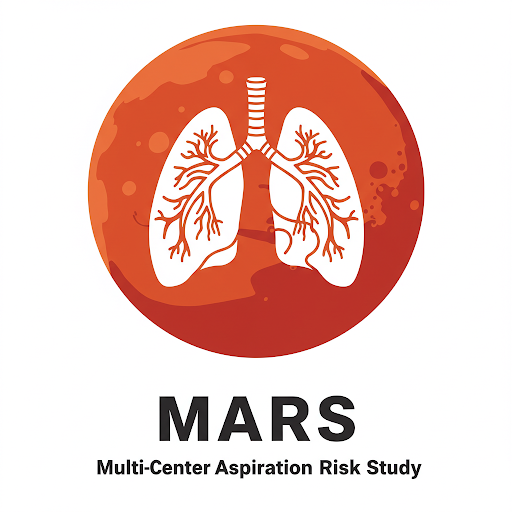
Study Protocol Summary
Australasian MARS: Australasian Multicentre Aspiration Risk Study
A pragmatic, multicentre observational cohort study comparing the rate of
pulmonary aspiration in hospitals with Sip Til Send fasting
versus restrictive preoperative fluid fasting
Lead investigators:
Dr Phuong Markman, Staff specialist anaesthetist
Dr Ruth Blank, Staff specialist anaesthetist
Department of Anaesthesia and Perioperative Medicine
Cairns Hospital, Cairns, Queensland, AUSTRALIA
BACKGROUND
Preoperative fasting is essential to minimise the risk of aspiration and 2 hours of fluid fasting in adults and 1 hour in children has been the standard recommendation [1]. However, with unpredictable theatre schedules, patients commonly end up fluid fasting for 7 to 13 hours [2]. Prolonged fluid deprivation can lead to thirst, nausea, anxiety, difficult IV access, hypotension during anaesthesia, and hypoglycaemia. Since 2022, a new program called “Sip Til Send” (STS) has been implemented across Australasia and in centres around the world, allowing patients to sip clear fluid until they are transported to theatre. The introduction of STS has successfully reduced fluid fasting times to 2 hours [3].
Although STS is gaining traction, its acceptance is still based on limited safety evidence from underpowered studies. Conducting adequately powered prospective randomised trials poses challenges due to the rarity of pulmonary aspiration, making it logistically difficult and expensive. There is consensus amongst the Australasian Sip Til Send Network that the best evidence for safety will be derived from pooling aspiration data into an Australasian multicentre study.
RESEARCH QUESTIONS
- Is the incidence of pulmonary aspiration in hospitals practicing STS non-inferior compared to that in hospitals practicing restrictive fluid fasting?
- What are the characteristics of the reported cases of aspiration?
METHODS
Study design
Multicentre observational cohort study of pulmonary aspiration during anaesthesia.
Hypothesis
The incidence of pulmonary aspiration in hospitals practicing Sip Til Send is non-inferior to that in hospitals practicing restrictive fluid fasting.
Setting
Participating hospitals across Australia and New Zealand, with central study co-ordinators located in Cairns Hospital, QLD.
Exposure
Patients of all ages will be included. Participating hospitals will continue their current fasting practices and report this accordingly. There is no requirement for a hospital to change their fasting program for the purpose of the study.
Outcomes
The primary outcome is the incidence of verified pulmonary aspiration. Secondary outcomes include the need for escalation of care due to aspiration events.
We will also conduct an exploratory analysis looking at variation in the incidence of aspiration between different hospitals according to reported fasting times and other known risk factors such as surgical specialty and patient demographics.
Data collection
The principal investigator from each participating hospital will provide reports to the central study co-ordinator based at Cairns Hospital. Each participating site submits reports at 1, 3, 6, 9 and 12 months after it starts data collection. The study will terminate once the total number of anaesthetics delivered reaches the pre-determined required sample size to power the study.
The reports will include:
- Number of verified pulmonary aspiration cases (numerator), with detailed information collected regarding each of these events (see below)
- Number of procedures under anaesthesia (denominator) and their characteristics (see below)
- Fluid fasting duration, obtained from hospital electronic records where available, or alternatively from random sampling of a subset of patients.
For each case of pulmonary aspiration, the report will contain the following data:
- Age
- Urgency of procedure (elective, emergency)
- ASA classification
- Surgical Subspecialty
- Phase of anaesthesia when aspiration occurred (induction, maintenance or emergence)
- Airway in situ at onset of aspiration
- Mode of anaesthesia – (general anaesthesia, unconscious sedation, conscious sedation, awake)
- Which diagnostic criteria for aspiration were met?
- New dependency on supplemental oxygen that persists after recovery unit stay
- Liquid or solid gastric content observed in or suctioned from the trachea
- New chest radiographic imaging suggestive of aspiration
- Did the aspiration lead to an escalation of care? (Unplanned intubation or re-intubation, increased stay in recovery unit, unplanned over-night hospital admission, unplanned stay in high-dependency or intensive care unit, ventilator therapy, hypoxic brain damage, death)
- When did the patient drink before induction? How much, and which fluid?
- When did the patient eat solid food before induction? What food and how much?
- (For paediatric cases) When did the child eat/drink milk-based food or breast milk? How much?
- Presence of risk factors for aspiration (BMI, diabetes, gastro-oesophageal reflux, GLP-1 receptor agonist therapy, previous bariatric surgery, Parkinson’s disease, sepsis, gastrointestinal obstruction,
For all anaesthetic cases completed during the study period (denominator), the report will contain the following data:
- ASA classification
- Age
- Fasting duration
- Urgency of procedure (elective, emergency)
- Surgical subspecialty
- Procedure name
- Anaesthetic type
- Whether pulmonary aspiration was reported for the patient
A data collection template is used to facilitate standardised and accurate data entry.
Definition of a verified pulmonary aspiration
Clinical suspicion of aspiration of gastric contents on the basis of coughing, bucking, regurgitation or vomiting during the induction, maintenance or emergence phases of anaesthesia, in conjunction with at least one of:
- New oxygen requirement persisting beyond the recovery unit
- Presence of gastric contents in the sub-glottic airways, as determined by bronchoscopy or endotracheal suctioning
- New radiographic findings suggestive of aspiration
Sample size and data analysis
In patients managed according to restrictive fluid fasting protocols, the reported incidence of aspiration under anaesthesia is 2 in 10,000 elective procedures for healthy populations, and 12 in 10,000 emergency procedures. For the purpose of this study, the non-inferiority limit was defined as a doubling of the incidence of aspiration. With these values as baselines for restrictive fluid fasting, we estimate the sample size required to demonstrate non-inferiority of Sip Til Send is 250,000, with 125,000 per arm comprising 113,000 elective procedures and 12,000 emergency procedures.
On an intention-to-treat basis, anaesthesia cases count as Sip Til Send cases if they have an anaesthetic in a hospital with an active STS program and belong to a group of patients in whom the hospital has decided to allow STS. These patients will be counted towards the STS group whether or not they were individually eligible for STS or actually participated in STS.
In addition to reporting on the primary outcome, we will aim to conduct additional exploratory analysis considering:
- The impact of fluid fasting duration on aspiration rates
- Exploration of variability in reported rates between different hospitals
- Assessment of risk factors identified in patients who have aspiration events
- Conducting interim analyses to ensure that enough data is collected to have adequate statistical power, and flag unexpectedly high or dangerous aspiration rates if these are observed
Hospital recruitment
Participating sites will be required to meet prerequisites before data collection can commence, including local governance approval and the presence of a robust audit system for identifying cases of aspiration. When any hospital has met these prerequisites, data collection can commence for that site. We anticipate staggered start dates as each hospital will progress at their own rate. Recruitment will end once the data accrued meets the pre-determined sample size requirement.
ETHICS AND GOVERNANCE
Multicentre ethics approval has been granted by the respective authorities in Australia and New Zealand, and recognised by all hospitals in their respective countries.
These include a waiver of the requirement to obtain direct informed consent.
IMPACT
The safe fasting of patients before surgery and prevention of aspiration under anaesthesia are fundamental goals in daily practice for anaesthetists, surgeons and theatre teams. STS is a simple and pragmatic solution to prolonged preoperative fasting, but robust, adequately-powered aspiration safety data do not yet exist. The Australasian MARS is expected to be world-first in providing a high quality and sufficiently large dataset for aspiration events for Sip Til Send hospitals. The outcome of Australasian MARS is likely to be of worldwide interest and widely generalisable to most patient groups.
REFERENCES
- The Australian and New Zealand College of Anaesthetists. PG07 Guideline on pre-anaesthesia consultation and patient preparation. 2024.
- Markman P, Grimmett W, Ramsay D, Sartain J, Stoeter D, Jaramillo C, et al. SipTilSend: Commentary from a national perspective. ANZCA Bulletin Summer 2023;32(4)
- Markman P, Nolan T. Sip Til Send Nation – Insights from the Australasian Sip Til Send Implementation Survey. ANZCA Bulletin Summer 2024:31-33.
